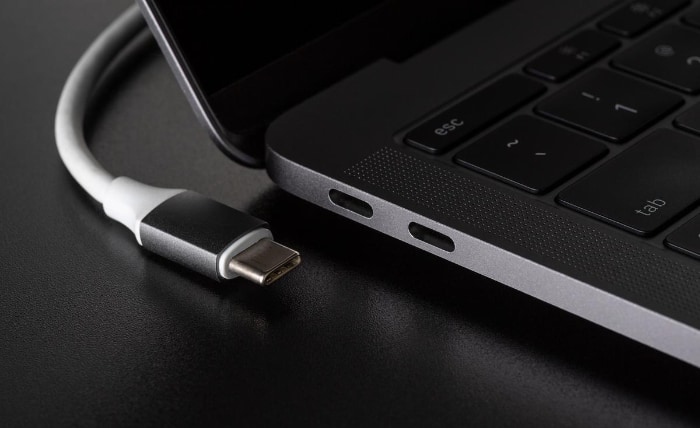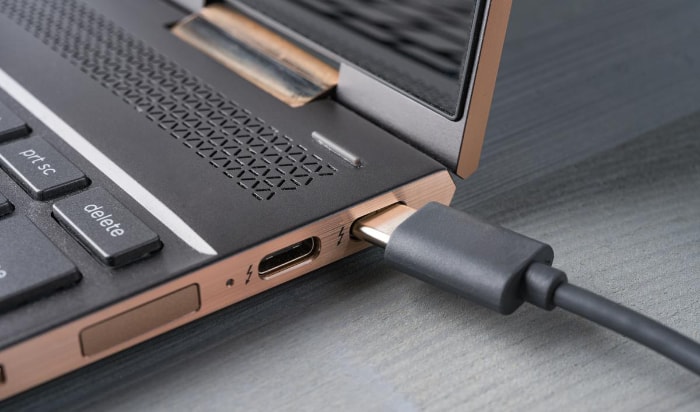Can I Charge My Phone with My USB-C Laptop Charger?

Charging your devices should be simple, right? You take a charger, plug it into the device, and voila—your phone, laptop, or gadget starts replenishing its battery life. However, as technology evolves, so do the specifications and complexities of these seemingly straightforward operations.
Enter the world of USB-C, a revolutionary interface that promises not just faster data transfer, but also universal charging capabilities. But hold on—can you really use your USB-C laptop charger to power up your phone? It’s a question that leaves many scratching their heads, given the various technicalities involved.
How USB-C Charging Works
The fundamentals of USB-C charging hinge on basic electrical principles, specifically how this advanced interface fine-tunes these elements for efficient and speedy power transfer.
Basic Electrical Concepts Behind Charging
Charging any device involves three primary electrical factors: voltage, current, and power. Voltage is the electrical force that pushes the current through the circuit, measured in volts (V).
Current is the rate of flow of electric charge, measured in amperes (A). Power, measured in watts (W), is the product of voltage and current, and it indicates the rate at which energy is consumed or produced.
USB-C Power Delivery Standard
USB-C separates itself from its predecessors through a feature known as Power Delivery (PD). This standard allows for higher levels of power to flow between devices, enabling faster charging and more efficient power usage.
Power Delivery dynamically negotiates the best power level for each connected device, ensuring that neither overcharging nor undercharging occurs. This dynamic adjustment sets the stage for universal charging capabilities, where a single charger could potentially charge a wide range of devices.
Dynamic Voltage and Current Adjustments
What sets USB-C apart is its ability to dynamically adjust voltage and current during the charging process. Traditional charging methods generally have fixed settings for voltage and current, meaning you would need different chargers for devices with different power requirements.
USB-C, on the other hand, can alter its voltage output in a range from 5V up to 20V, and its current from 1A to 5A, depending on the device’s need. This flexibility ensures not only faster charging but also broader compatibility among various gadgets.
Charging Profiles
USB-C chargers often come with different charging profiles, which define the combinations of voltage and current that a charger can offer. For example, a charger might offer a 5V/3A profile for smartphones and a 20V/5A profile for laptops.
When you connect a device, the charger and device communicate to select the most appropriate profile, ensuring an efficient and speedy charging process.
USB-C to USB-C vs USB-C to Other Formats
When charging, using a USB-C to USB-C cable is the most straightforward way to take advantage of all the features that USB-C has to offer. However, adapters and converter cables exist to bridge USB-C with older formats like USB-A.
While these can be useful, they often limit the benefits you can gain from USB-C’s advanced capabilities, such as the dynamic adjustments of voltage and current.
Factors that Determine Compatibility
When considering the use of a USB-C laptop charger for your phone, it’s critical to evaluate the compatibility between the two devices. Compatibility hinges on a range of technical specifications from both the charger and the phone.
Wattage Ratings
One of the primary indicators of compatibility is the wattage rating of both the charger and the phone. The charger’s maximum output wattage and the phone’s maximum input wattage must align for safe and efficient charging.
For example, if a laptop charger offers an output of 65W and a phone has a maximum input of 18W, it’s important to check whether the charger can scale down its output to match the phone’s requirement.
Voltage and Current Compatibility
Aside from wattage, voltage and current also play essential roles. Both devices should support the same range of voltages and currents to ensure that neither overcharging nor undercharging occurs.
Most modern devices are equipped with smart charging circuits that can adjust these variables, but it’s always best to double-check the specs to avoid any unforeseen issues.
USB-C Specifications
USB-C is not just a single standard but an array of sub-standards, including USB 2.0, USB 3.0, USB 3.1, USB 3.2, and USB 4. The specific USB-C sub-standard that your charger and phone support can significantly impact their compatibility.
Generally, devices made to newer standards are backward compatible with older ones, but this is not always a guarantee for optimal performance.
Smart Charging Features
Many modern phones and chargers come equipped with smart charging features, which can identify the type of device connected and adjust the power output accordingly. However, some older or less advanced chargers may not have this capability, potentially leading to slower charging times or, in the worst case, damage to the phone’s battery.
Real-World Limitations and Manufacturing Variability
While technical specifications offer a robust framework for compatibility, real-world variables like manufacturing tolerances can impact performance. Two chargers with identical specifications may not deliver the exact same level of performance due to variations in components or quality control.
Risks of Incompatibility

While USB-C’s promise of universal compatibility is appealing, it’s not without risks when devices are misaligned in their technical specifications. The consequences can range from minor annoyances like slow charging to more serious issues such as hardware damage or safety hazards.
Overheating Issues
One of the most common problems arising from charger incompatibility is overheating. A charger supplying more current or voltage than a phone can handle can cause the device to heat excessively.
Overheating can reduce the lifespan of the battery and even lead to hardware damage.
Potential Damage to Phone Battery or Charging Circuit
If a charger delivers power at levels outside the safe operating range of the phone, there’s a risk of damaging the battery or the phone’s internal charging circuit. In extreme cases, this could render the device inoperable.
Nullification of Device Warranties
Using incompatible chargers can often void your device’s warranty. Manufacturers stipulate the conditions under which their devices should be used and charged.
Deviating from these guidelines can nullify any warranty claims you might have in the future.
Safety Concerns and Hazards
In worst-case scenarios, using incompatible chargers can lead to serious safety concerns like electrical shocks or fires. Although rare, these incidents are severe enough to warrant caution when selecting a charger for your devices.
Reduced Charging Efficiency
While not as critical as the other risks mentioned, an incompatible charger can reduce the efficiency of the charging process, resulting in longer charging times. Inefficient charging can also waste energy, which is not only bad for your utility bill but also detrimental to the environment.
Tips for Safe Charging
To mitigate the risks associated with using a USB-C laptop charger for your phone, it’s essential to follow best practices for safe and efficient charging.
Check the Specifications
Always read the fine print. It’s crucial to review the technical specifications of both your charger and your device to ensure compatibility.
Look for voltage, current, and wattage ratings and make sure they align between the charger and the phone.
Use Trusted Brands and Certified Products
When selecting a charger, opting for well-known brands that have a reputation for quality can offer an extra layer of safety. These companies usually adhere to strict manufacturing standards, which minimizes the risk of technical issues.
Also, look for chargers that have certifications from recognized standards organizations.
Regularly Inspect Chargers and Cables
Wear and tear can affect the performance and safety of your charger and cables. Regularly check for any frayed wires, bent connectors, or other signs of damage.
If you notice any of these issues, it’s best to replace the faulty component immediately.
Avoid Overcharging
Although most modern devices are designed to stop charging when they reach 100%, keeping your phone plugged in for extended periods can still lead to inefficiencies and may degrade battery lifespan over time. Unplugging your device when it reaches full charge is a good habit to cultivate.
Test with Small Charging Periods
If you’re unsure about compatibility, it may be wise to perform a short charging test. Plug your phone into the charger for a short duration, such as 10 to 15 minutes, while monitoring the device’s temperature and charging status.
This short-term test can help you gauge whether the charger and device are well-matched, but it’s not a substitute for checking technical specifications.
Conclusion
To sum up, the possibility of charging your phone with a USB-C laptop charger hinges on several factors, including compatibility of wattage ratings, voltage and current requirements, and USB-C specifications. While the flexibility of USB-C offers the appealing prospect of universal charging, it also introduces risks such as overheating, reduced charging efficiency, and even potential damage to your devices.
Being diligent about checking specifications and following best practices for safe charging can mitigate these risks substantially. This comprehensive overview serves to equip you with the necessary information to make informed decisions about using USB-C chargers across different devices.


